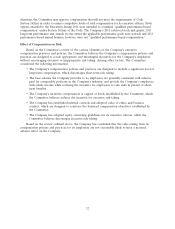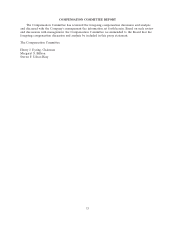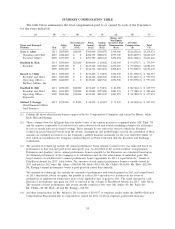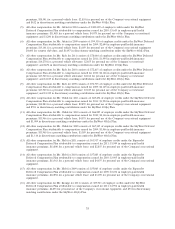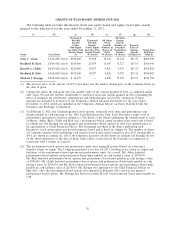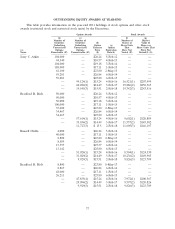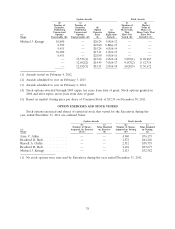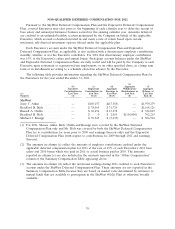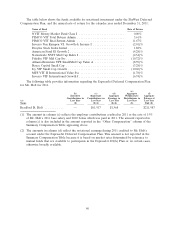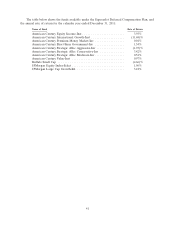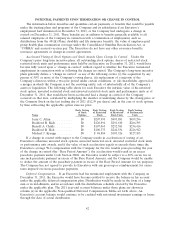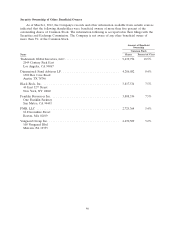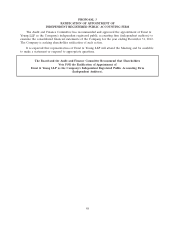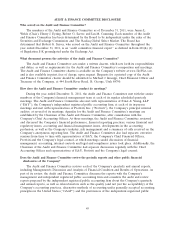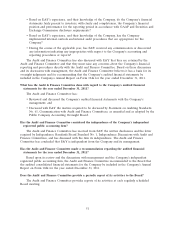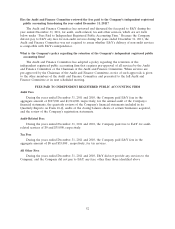SkyWest Airlines 2011 Annual Report Download - page 153
Download and view the complete annual report
Please find page 153 of the 2011 SkyWest Airlines annual report below. You can navigate through the pages in the report by either clicking on the pages listed below, or by using the keyword search tool below to find specific information within the annual report.
POTENTIAL PAYMENTS UPON TERMINATION OR CHANGE IN CONTROL
The information below describes and quantifies certain payments or benefits that would be payable
under the existing plans and programs of the Company and its subsidiaries if an Executive’s
employment had terminated on December 31, 2011, or the Company had undergone a change in
control on December 31, 2011. These benefits are in addition to benefits generally available to all
salaried employees of the Company in connection with a termination of employment, such as
distributions from the 401(k) Plans, disability and life insurance benefits, the value of employee-paid
group health plan continuation coverage under the Consolidated Omnibus Reconciliation Act, or
‘‘COBRA’’ and accrued vacation pay. The Executives do not have any other severance benefits,
severance agreements or change-in-control agreements.
Accelerated Vesting of Stock Options and Stock Awards Upon Change In Control. Under the
Company’s prior long-term incentive plans, all outstanding stock options, shares of restricted stock,
restricted stock units and performance units held by an Executive on December 31, 2011, would have
become fully vested upon a ‘‘change in control’’ without regard to whether the Executive terminated
employment in connection with or following the change in control. The Company’s long-term incentive
plans generally define a ‘‘change in control’’ as any of the following events: (i) the acquisition by any
person of 50% or more of the Company’s voting shares, (ii) replacement of a majority of the
Company’s directors within a two-year period under certain conditions, or (iii) shareholder approval of
a merger in which the Company is not the surviving entity, sale of substantially all of the Company’s
assets or liquidation. The following table shows for each Executive the intrinsic value of his unvested
stock option, unvested restricted stock and unvested restricted stock units and performance units as of
December 31, 2011, that would have been accelerated had a change in control of the Company
occurred on that date, calculated by multiplying the number of underlying shares by the closing price of
the Common Stock on the last trading day of 2011 ($12.59 per share) and, in the case of stock options,
by then subtracting the applicable option exercise price:
Early Vesting Early Vesting Early Vesting Early Vesting
of Stock of Restricted of Restricted of Performance
Name Options Stock Stock Units Units
Jerry C. Atkin ............ $0 $207,995 $493,881 $459,296
Bradford R. Rich .......... $0 $120,894 $291,610 $266,395
Russell A. Childs .......... $0 $107,065 $252,581 $236,416
Bradford R. Holt .......... $0 $100,373 $244,536 $226,922
Michael J. Kraupp ......... $0 $ 48,884 $103,326 $127,105
If a change in control with respect to the Company results in acceleration of vesting of an
Executive’s otherwise unvested stock options, unvested restricted stock, unvested restricted stock units
or performance unit awards, and if the value of such acceleration equals or exceeds three times the
Executive’s average W-2 compensation with the Company for the five taxable years preceding the year
of the change in control (the ‘‘Base Period Amount’’), the acceleration would result in an excess
parachute payment under Code Section 280G. An Executive would be subject to a 20% excise tax on
any such parachute payment in excess of the Base Period Amount, and the Company would be unable
to deduct the amount of the parachute payment in excess of the Base Period Amount for tax purposes.
The Company has not agreed to provide its Executives with any gross-up or reimbursement for excise
taxes imposed on excess parachute payments.
Deferred Compensation. If an Executive had his terminated employment with the Company on
December 31, 2011, the Executive would have become entitled to receive the balance in his account
under the applicable deferred compensation plan. Distribution would be made in the form of a lump
sum or in installments, and in accordance with the distributions schedule elected by the Executive
under the applicable plan. The 2011 year-end account balances under those plans are shown in
column (e) in the applicable Non-qualified Deferred Compensation Tables set forth above. An
Executive’s account balance would continue to be credited with notational investment earnings or losses
through the date of actual distribution.
42


